Allen Tiller's Blog, page 22
August 11, 2020
A Haunting at the Cornucopia Hotel - Wallaroo
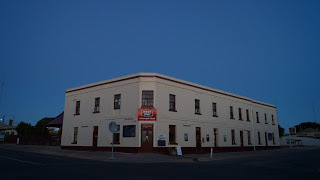
This month we are travelling to the Copper Coast to the historic mining seaside town of Wallaroo to visit one of my favourite haunts in the area – the Cornucopia Hotel, located at 40 Owen Terrace, right in the heart of the historic town.
It was also home, in the early days, like many hotels in that era, as the staging point for coroner inquests into local deaths. Often this would see the body laid out, with Doctors, Judges and other local dignitaries sitting around deciding if there was more to a death then an accident or natural causes.
I have investigated the hotel on a number of occasions, both privately and with the public, and have encountered some very strange phenome within its walls.
The upstairs section of the hotel houses the guest’s suites and shared shower facilities. This seems to be the epicentre of the haunting, particularly in the one wing containing bedrooms 11 through to 13.
On one occasion, about the middle of the day, I was standing in the junction of the hallways, which wind and turn through the upper levels. In one spot I could smell very distinctly the smell of the ocean and old tobacco, but take a step in any direction and the smell would be completely gone. Now, not being one to jump to the “ghost” conclusion in an instant, I put it down to being so close to the ocean, and the smell of tobacco being embedded in the walls and carpets, and didn’t think any more of it, until I went downstairs to the dining room and a psychic told me that right above us was a spirit of an old Swedish sailor who had died elsewhere, but returned here as he felt this was home – (this still did not convince me the place is haunted by a Swedish sailor!).
On another occasion, my wife experienced very strange disembodied footsteps in the hallway whilst she was investigating in room 10, at the same time, I was sitting on the bed in room 11 and recorded an EVP that asked the question “Hello?” – this was only the beginning of weird occurrences in the upstairs area that evening,
Whilst in another upstairs room we all experienced equipment responses to questions. One investigator also heard a disembodied voice within the room.
During a public event in the Cornucopia Hotel, Rob from “Cityside Paranormal” had a poltergeist event occur. Rob and his partner was staying in room 11, he put his clothes and gear in the room, and during the tour part of the event, re-entered his room to find all his belongings were strewn about the place as if someone had been recklessly searching for some mysterious object!
So who haunts the Cornucopia Hotel? It could be Archibald Samuels, a young man, aged 14, who lost his life in a water tank that is located directly underneath the current bear garden. Archibald had gone to draw water from the tank and somehow fell in, only to be found the following day when the hotel couldn’t find him to run an errand.
 Or, perhaps it might be Mr Crawford, who had a nasty gash upon his leg that went gangrene, he died in an upstairs bedroom.
Or, perhaps it might be Mr Crawford, who had a nasty gash upon his leg that went gangrene, he died in an upstairs bedroom.Many of the staff have told me stories of suicides that go unreported in the local media, one involved a young woman hanging herself from the balcony in full site of the town’s main street – it is said she may be the ghost often heard speaking in room 9, that also likes the roll bars of soap across the room.
Another mysterious paranormal event occurred in February 1894 when a fire broke out in the hotel stables (as reported in The Kadina and Wallaroo Times – 3 Feb 1894). Albert Swanski, the horse keeper locked the stables at 11pm, and when he checked the horses at 7:30am, he found the stalls and horses very badly burnt, so badly, in fact, the vet put them down immediately (they are buried in the hotel grounds). All the leather bridles, reigns etc of the horses were perfect, uncharred, no fire or smoke damage. No one knew how the fire started, or how it got put out, all the locks were still intact, and no entry points could be seen – very strange indeed!
The Cornucopia Hotel Wallaroo remains a popular drinking spot within the town and depending on who you talk too, one of the most haunted pubs on the Copper Coast!
My thanks to Rick and Will Parson of Flinders Ranges Paranormal Research Group for assistance with research on this historic location.
<edit> The Cornucopia Hotel is now known as the Copper Coast Hotel.
Allen Tiller is the Australian star of the international hit television show “Haunting: Australia” and author of “The Haunts of Adelaide – History, Mystery and the Paranormal” as well as being a historian, lecturer, poet, musician, Tour Guide, blogger and podcaster. Allen is also a volunteer for many different associations and groups.
You can find Allen online at:
www.facebook.com/AllenHauntingAustralia
https://www.facebook.com/TheHauntsOfAdelaide
First published in MEGAscene issue 7 2016
© Allen Tiller
August 4, 2020
A Haunting at the National Railway Museum
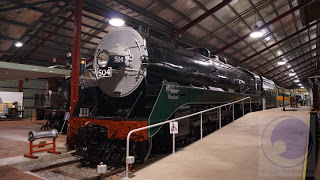
Located in Port Adelaide, The National Railway Museum offers a glimpse into South Australia’s railway past. Within its many sheds sit old trains from all eras of our railway past, including Steam Trains, Diesel Engines, old Red Hens and even the old Callington Railway Station, but did you know, there are also claims the site is haunted?
The National Railway Museum started originally on Railway Terrace, Mile End in 1963 and was run entirely by volunteers, who not only restored and preserved old trains but wrote and published books about them too.
In 1988 the volunteers sought a new site where their trains could be kept undercover to keep them out of the weather, and in pristine condition. After a Government grant and help from the History Trust of SA, a new site was purchased.
The Port Dock Station Railway Museum was opened in 1988. In 2001 a new facility was opened within the existing one that featured exhibits from the Australian National Railways and the Commonwealth Railways. With the new exhibit came a new name for the site, one that remains today “The National Railway Museum Port Adelaide”.
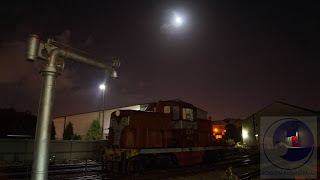 The original railway station stood where the Port Adelaide Police Station now sits and was opened in 1856. This was one of the first lines in South Australia and the mainline to the ports. The station closed in 1981, but the goods sheds and railway yards remained, which is now the site of the museum.
The original railway station stood where the Port Adelaide Police Station now sits and was opened in 1856. This was one of the first lines in South Australia and the mainline to the ports. The station closed in 1981, but the goods sheds and railway yards remained, which is now the site of the museum.Within the complex are a series of sheds containing many displays of railway related items, including a miniature train set and old steam train carriages one can walkthrough. There is also the original 1878 Port Dock Station goods shed on the eastern side of the complex, and the old Callington booking office, which was built in 1951 in the town of Callington, near Murray Bridge. The building was taken from Callington in 1991 and re-erected in Port Adelaide in 1994.
The museum also has in its collection an original coffin trolley used until 1982 the Adelaide Railway Station to transport coffins by hand through the terminal.
My father worked in the railways, as did both his parents, so trains were a big part of my life growing up. My wife and I, and my Mother-In-Law had investigated the Steamtown Heritage Rail Centre in 2011, and had some great experiences, so when we were invited to join Lyon Paranormal, Paranormal Spectrum and The Ghosts Within to investigate the National Railway Museum for paranormal activity, my whole team made themselves available for the opportunity!
There had been ongoing reports of spooky thing happening at the site, including reports of a shadow person, and of phones ringing when they are not plugged into the wall.
It is thought that one of the trains, the “Y 12” may, in fact, be the very train that was involved in Australia’s first terror attack, at Silverton, near Broken Hill. On New Year’s Day 1915, two Turkish men opened fire into the carriages this locomotive which was hauling, a picnic train, killing a number of passengers. It is believed by some parties that the spirits of those deceased may linger near the locomotive.
Other deaths onsite include railway workers killed while working in the rail yard shunting trains. There is also an unconfirmed story of a man who fell asleep on the rails whilst very drunk and was run over by a train.
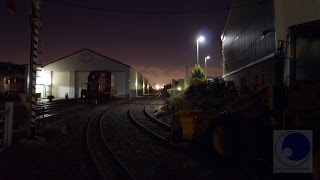 We investigated as many carriages and trains as we could enter on the night, but for us, it seemed the spirits did not want to communicate. However, Paranormal Spectrum’s investigators did manage to collect an EVP during their sessions.
We investigated as many carriages and trains as we could enter on the night, but for us, it seemed the spirits did not want to communicate. However, Paranormal Spectrum’s investigators did manage to collect an EVP during their sessions. The National Railway Museum Port Adelaide is located at 76 Lipson Street Port Adelaide – you can find more information about exhibits and the train via their website at: http://www.natrailmuseum.org.au/
Allen Tiller is the Australian star of the international hit television show “Haunting: Australia” and author of “The Haunts of Adelaide – History, Mystery and the Paranormal” as well as being a historian, lecturer, poet, musician, Tour Guide, blogger and podcaster. Allen is also a volunteer for many different associations and groups.
You can find Allen online at:
www.facebook.com/AllenHauntingAustralia
https://www.facebook.com/TheHauntsOfAdelaide
First published in MEGAscene issue 6 2016
© Allen Tiller
July 28, 2020
Haunted Highercombe Hotel Museum
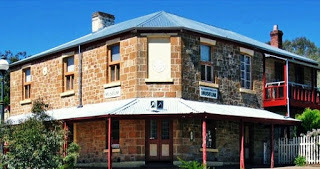
Every year I have the pleasure of visiting locations haunted locations around Australia. 2015 was no different, with investigations at the Boggo Road Gaol in Queensland, Geelong Gaol, Beechworth Lunatic Asylum in Victoria and a return to Woodford Academy in New South Wales. In South Australia, the journey has taken in Old Adelaide Gaol, The Cornucopia Hotel in Wallaroo, investigations in Willunga, Kapunda, Gladstone and Edinburgh, but one of the more interesting locations for me, this year has been a small scale investigation in a historic location, the Highercombe Hotel Museum in Tea Tree Gully.
In 1853 when the Highercombe Hotel was built in the town of “Steventon”, now known as Tea Tree Gully. The population was of a reasonable size, but not one big enough to support the Highercombe Hotel and the Tea Tree Gully Inn which stood across the road. The Highercombe Hotel had a short-lived existence as a local pub, closing its doors as a hotel only 24 years after opening.
The Tea Tree Gully Hotel became a major stopping point for stagecoaches and horse riders after the main road in the area was diverted right past its front door.
The northern side of the Highercombe Hotel building served as the local post office and post-masters residence from 1879 until 1963. From 1875 until 1934 the southern side of the building was lived in by the headteacher of the Tea Tree Gully Public School. After this, for 20 years from 1930, the southern side was rented to the Hughes family as a private residence.
For a small period in the 1960s the building served as the library and office for the Tea Tre Gully Council, until it was bequeathed to the National Trust in 1967 when it’s life as a museum was imagined.
In 2015 the site has been renamed “The Tea Tree Gully Heritage Museum” and is run entirely by volunteers
Whilst I have found no deaths in my current research on the building that could lend credence to a possible haunting, the building contains a number of personal effects that could promote the theory of “attachment”. “Attachment” is the theory that some paranormal investigators subscribe too, that some objects are so loved and adored by their owners or had such importance in their lives, that, in death, they still cannot bear to part with the object. This, in turn, leads to sightings of the spirit near its beloved object – as would appear to be the case here in this building.
One sighting has been of a young girl sitting in front of the fireplace in the large downstairs sitting-room at the entrance side of the Hotel. This teenage girl has been seen briefly by volunteers, sitting quietly, as if enjoying, or warming herself in front of the fire.
Whilst investigating with my team, Eidolon Paranormal, and friend Karina Eames, we had our own brief unexplained experience in an upstairs room when reading poetry that was bequeathed to the museum in an estate. Whilst Karina and Karen were reading the poetry aloud, another investigator witnessed a small white light pass between two investigators and then vanish – at the same time goosebumps and coldness was felt by the investigators.
At this stage we are still reviewing our investigation data, and looking towards further investigations in the former hotel to uncover who could possibly be haunting the building.
The museum can be visited by the public on open days or through group bookings by visiting the volunteer society’s website at – http://www.highercombemuseum.on.net/
Allen Tiller is the Australian star of the international hit television show “Haunting: Australia” and author of “The Haunts of Adelaide – History, Mystery and the Paranormal” as well as being a historian, lecturer, poet, musician, Tour Guide, blogger and podcaster. Allen is also a volunteer for many different associations and groups.
You can find Allen online at:
www.facebook.com/AllenHauntingAustralia
https://www.facebook.com/TheHauntsOfAdelaide
First published in MEGAscene issue 5 2016
© Allen Tiller
July 21, 2020
The Haunting of Martindale Hall
The Haunting of Martindale Hall
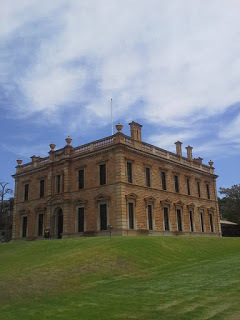
A visit to the Clare valley with our good friends John & Deb from Drifter Paranormal (who are travelling the country investigating haunting phenomena) led us to Mintaro’s exceptional Georgian styled manor “Martindale Hall”.
The mansion was constructed in 1879 and took two years to finish. It is built out of sandstone and has 32 rooms, including a large basement which contains seven rooms.
The house was used as Mr Bowmans own recreation home, and featured a boating lake, racecourse, cricket pitch (which saw the English 11 play on its pitch on one occasion), a polo ground, and was also used for fox hunting and other hunting exhibitions.
Its roof was designed to allow for the lady visitors of the house to sit upon and view the goings-on of the sporting achievements of the menfolk.
It is said that Mr Bowman’s wealth was extraordinary and that he spared no expense in building the house, which cost somewhere around 72 thousand pounds. The extravagance is quite evident when visiting the mansion and its extraordinary coach house (which is larger than a lot of people’s entire homes). There are long-held local legends that back in Bowman's day when only he and his two brothers lived in the home, and later just Edmund and his wife Annie, that Bowman had 14 servant’s, 4 of which lived on site. Much like TV shows like “downtown Abbey” or “Upstairs Downstairs” the home had areas purely for the use and movement of servant’s.
This was a man so wealthy, he installed fully flushing toilets for his servant’s use, but insisted on using commodes for himself and his guests, which the servants would have to empty after each use.
The White Carra Marble Fire Place in the Drawing room at Martindale Hall was entered into a competition in France, where it took first prize at a Paris exhibition in 1873 and was purchased by Mr Bowman for 75 pounds.
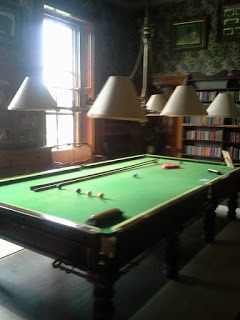
The house is now a museum owned by the people of South Australia, and within its walls, you can find all its original fittings and grandeur. In the billiard room stands a full-sized English Billiard table (12 ft x 6 ft). It is said the 1.5-tonne pool table was placed in position, then the north-facing wall of the building was finished.
In 1885, drought overtook Australia, and Edmund Bowman's finances suffered, this was compounded further in following years with a depression lowering the price of wool, causing Mr Bowmans finances further losses. These losses eventually led to the sale of Martindale Estate to another notable South Australian, Mr William Mortlock in 1891.
The Mortlock’s brought their own touch to the home and the majority of the fittings and furniture that we see today were theirs. In the smoking-room, one can see some of the treasures that John Mortlock returned with from his expeditions across Australia, New Guinea and Africa including a majestic 16th-century Samurai suit, Sri Lankan devil masks and carved elephant tusks. Other pieces of Mr Mortlocks collection can be found in the Adelaide Museum and Mortlock Library on North Terrace Adelaide.
John Mortlock, who inherited the house from his parents, died in 1950, only 15 months after marrying his wife, Dorothy. After John’s death, Dorothy walked out of the house, leaving everything the way it sat, other than a few personal possessions. She locked the door and then donated the entire building and contents to the University of Adelaide, which in turn gave the entire site to the people of South Australia.
Unfortunately, the State Government is currently trying to usurp the public and sell the site to a private consortium to start a “wellness clinic”, taking away the public’s right to visit a site that was bequeathed to them.
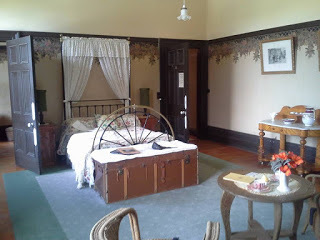
Away from the politics, beauty and history, Martindale has long been deemed a significant haunted historic location in the Clare Valley region.
Many of the staff, and some of the visitors and overnight staying guests have reported strange goings-on, and sightings of mysterious people in the grounds, and inside the home itself.
A man has been seen, in period clothing, possibly early 1900’s, sitting on the back stairs of the home. The clothing worn, and the site where he has been seen would indicate the possibility of a servant, perhaps one who loved his masters, and the house far too much to move on after his death.
Overnight staying guests have reported waking up and finding a child lying in bed with them, when no children have been reported to be in the home. Other people have reported seeing children, in “olden-times” clothing playing on the front steps of the mansion, running around, not noticing the adults staring at them in bewilderment, before the children fade into the surroundings…
The most often seen spirit in the Home though is thought to be the spirit of Valentine Mortlock. Valentine was born on Valentine’s Day, thus his name. He was born with “cretinism” which is described on Wikipedia as “is a condition of severely stunted physical and mental growth due to untreated congenital deficiency of thyroid hormones”.
Valentine lived much of his life confined to his room, perhaps this was because of his disability, but more likely it is because his well to do family saw his disability as a blight upon their name.
Valentine had long blonde hair, which was common for young boys of the period, and very often, when he was seen, he would be mistaken for a little girl, this could explain the sightings of a long haired blonde spirit girl inside the hall, mistaken identity!
The most notable recent sighting of Valentine was recorded by the caretakers of Martindale Hall and is displayed in his room for all to read.
It tells of a 3-year-old boy, visiting the house with his family. The boy’s mother went to take the boy out of the room, but he did not want to leave his new friend, who he described as having long golden hair, and “looking like an angel”.
Or – visit the Martindale Hall website to plan your visit: - http://www.martindalehall-mintaro.com.au/
Allen Tiller is the Australian star of the international hit television show “Haunting: Australia” and author of “The Haunts of Adelaide – History, Mystery and the Paranormal” as well as being a historian, lecturer, poet, musician, Tour Guide, blogger and podcaster. Allen is also a volunteer for many different associations and groups.
You can find Allen online at:
www.facebook.com/AllenHauntingAustralia
https://www.facebook.com/TheHauntsOfAdelaide
First published in MEGAscene issue 4 Jan 2016
©Allen Tiller
July 13, 2020
The Old Adelaide Gaol
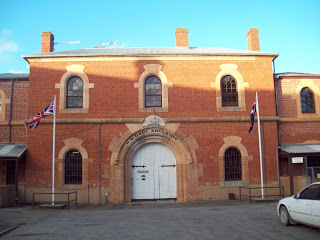
A siren mourned woefully at 8am in the north-west end of Adelaide city, marking the moment of the final throes of life of executed man, Glen Sabre Valance at Her Majesty’s Adelaide Gaol.
The 45th execution within the gaol walls and the last hanging undertook inside the gaol. 44 men and one woman, Elizabeth Woolcock lost their lives by hanging in the gaol for various crimes since the establishment of the gaol in 1841.
From 1841 until 1988, The Adelaide Gaol held over 300,000 prisoners and was Australia’s longest-serving continuous gaol. It housed men, women and children, and sometimes lunatics.
The first Governor was William Baker Ashton, who was actually appointed 2 years before the gaol opened. William and his wife Charlotte (who acted as the Gaol Matron until 1850) had 6 children, with three of them being born during their time at the gaol
In 1854, William, a very large man, died unexpectedly in the upstairs office of the gaol, the narrow staircase could not accommodate the size of his dead body, so he had to be lowered down through a window to the ground below.
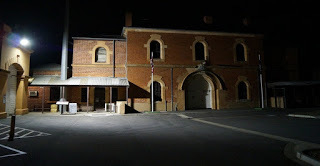
Another infamous character of the Old Adelaide Gaol is the resident hangman, Mr Benjamin Ellis. Ellis acted as the executioner for 10 years at the gaol, and lived on-site at the time to help protect his identity.
His lodgings were directly underneath the female dormitories, where he is said to haunt until this day.
Not much is known about the man, expect he was very good at his job and undertook it in a precise and serious manner.
Ellis would eventually leave his profession after two hangings that haunted him. The first was the only hanging of a female in the Adelaide Gaol, Elizabeth Woolcock.
Mrs Woolcock had been found guilty of poisoning her husband with mercury and sentenced to death. There are to this day, many who claim she was not guilty of the crime, but that did not stop her execution on December 30th 1873.
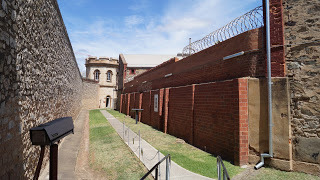
The second hanging, and possibly Ellis last, was that of Charles Strietman in 1877. Ellis went about his work in a serious manner he always conducted his business, but for some reason, on this occasion, he forgot to secure the man’s ankles and feet. When Strietman fell through the trap door, his feet hit the trap, and he was able to pull himself back up onto the platform.
One of the 13 witnesses present then pushed Strietmens legs off the trap until he fell and hung. It was reported in the newspapers the following day that it then took Strietman over 23 minutes before he died from hanging.
Ellis, who is described as an ugly man with a large bulbous nose is often seen within the gaol walls, wandering aimlessly – perhaps for his part in so many executions, his afterlife is to be spent within the gaol walls, or perhaps he is looking for his next execution.
Elizabeth Woolcock is also said to haunt the gaol walls, dressed in a long white gown, she is seen in the women’s yards and cells from time to time during the day.
John Balaban was a notorious and sadistic murderer in South Australia. He came to Adelaide from Romania where he worked as an industrial chemist.
In 1953, Balaban committed a triple murder when he killed his wife Thelma, her six-year-old son from a previous marriage, Philip and Thelma’s 66-year-old Mother, Susan Ackland.in the rooms above the sunshine café where the family lived.
He then turned his attention on Verna Maine, a 24-year-old waitress in the café. Vera, to escape Balaban, jumped out through an upstairs window. She lay on the footpath critically injured from the fall, but was lucky to escape, with witnesses able to call the police and thus, save her life.
Balaban was swiftly arrested and quickly confessed to another murder, that of 29-year-old Zora Kusic.
It was eventually the murder of Zora that got Balaban executed at the Adelaide Gaol on the 27th of August 1953, but it would seem he still lingers within the walls where his body, and that of 45 other executed prisoners remain.
Balaban has been seen on occasion near the hanging tower, looking remorsefully at his feet – perhaps contemplating his eternal fate within the foreboding walls of The Adelaide Gaol.
Many of you will be happy to know that the ghost tours, that were run by the Adelaide Gaol Preservation Society for almost 25 years are returning this November for their famous tours...
Adelaide Gaol Preservation Society are professional and offer unique experiences in ghost tours, workshops and other paranormal related outings.
You can find out more information through the Adelaide Gaol Preservation Website at : http://Adelaidegaol.org
Or via facebook:
https://www.facebook.com/AdelaideGaolPreservationSociety
First published in MEGAscene Issue 3, Novemeber 2015.
Written and Researched by Allen Tiller.
©2015 Allen Tiller.
Allen Tiller is the Australian star of the international hit television show “Haunting: Australia” and author of
“The Haunts of Adelaide – History, Mystery and the Paranormal” as well as being a historian, lecturer,
poet, musician, Tour Guide, blogger and podcaster. Allen is also a volunteer for many different associations and groups.
You can find Allen online at:
www.twitter.com/Allen_Tiller
www.facebook.com/AllenHauntingAustralia
https://www.facebook.com/TheHauntsOfA...
May 19, 2020
Terowie Train Station - Hidden Secrets
Terowie Train Station - Hidden Secrets
<Begin Transcript>
The mid-north town of Terowie sits 220 kilometres north of Adelaide, in South Australia. It is an important landmark town in the state for its many historical buildings. Terowie Train Station opened in 1880 when the broad-gauge railway line from Adelaide reached the town. The first train arrived on December 14, 1880, carrying Sir William Jervois, Governor of South Australia
Not long after, a narrow-gauge line from nearby Peterborough was extended to Terowie station. Terowie railway station, from then on, was used to unload goods from the broad-gauge line, onto trains on the narrow-gauge line, to move goods through the state, and interstate. The Adelaide to Red Hill railway line was extended to Port Pirie in 1937, taking away some of Terowie’s train traffic. When Leigh Creek Coalfields opened, traffic through Terowie increased again, but this line was soon made obsolete with a new Stirling to Maree line opening in 1957. The Port Augusta to Broken Hill line was converted to a standard gauge, which saw railway lines north of Terowie converted to broad gauge in1970, making Peterborough the breakpoint of gauges and rendering Terowie obsolete.During World War Two. A large military camp was established close the railway station, enabling the military to move troops and ammunition swiftly across Australia to wherever needed. The break of gauge at Terowie meant that the town was vital for the Silverton to Burra, Adelaide to Perth and Adelaide to Alice Springs routes. During the War, all north-bound men and goods were transhipped at Terowie.While changing trains on the 20th of March 1942 at Terowie U.S. General MacArthur made a speech about the Battle of The Philippines, in which he said:. “I came out of Bataan and I shall return”.The Terowie line was reduced to a crossing loop with the line closing in July 1988,Today Terowie is a historical town much loved by its residents. The train station stands as a monument to the railway workers that opened up the outback to exploration, commerce and tourism. <End Transcript>
Researched by Allen Tiller
March 6, 2020
Cornwall Hotel - Paranormal Investigation
WATCH THE VIDEO ABOVE!Eidolon Paranormal was invited by When The Lights Go Out Paranormal to investigate the alleged haunting of the Cornwall Hotel in Moonta, South Australia. While experimenting with the Project Paranormal ITC app, the teams captured a very clear command.
Is this evidence of the paranormal?
When The Lights Go Out Paranormal - Facebook: https://www.facebook.com/whenthelight...
Eidolon Paranormal - Facebook: https://www.facebook.com/EidolonParan...
Spirit Tech: https://www.facebook.com/wombatelectr...
Project Paranormal App: https://play.google.com/store/apps/de...
Hidden Secrets - Dead Mans Pass - Gawler
Hidden Secrets – ‘Dead Man’s Pass – Gawler’
<Transcript> Before European settlement, Dead Man’s Pass and the Gawler region was the home to the indigenous Kaurna Peoples.
Known originally to European settlers as The Para Pass, the river crossing was first used circa 1836. Colonel William Light is recorded as having stayed at a camp near the pass in 1837, while exploring the Barossa Valley region and attempting to find passage through the Mount Lofty Ranges towards the Murray River. The crossing got its name after an exploration party returning from the Barossa ranges came across an exhausted traveller, whom they offered respite too. Once stopped at the crossing they checked on their new companion who had fallen asleep in the back of their dray, only to find him dead. Having no tools with which to dig a grave, they placed his body upright in a hollow tree and covered it as best they could with sticks and branches.Not long after, another travelling party happened across the gruesome site, and, after taking samples of the gentleman’s clothing, encased him with clay in the tree. The name “Dead Man’s Pass” was adopted circa 1842 as the permanent name of the South Para River ford, in honour of the dead man found in the hollow coffin tree.
There are many different accounts of the finding of the dead man. No one is certain which account is true. Perhaps there is a little truth to be found within each version of the story. Dr George Nott wrote of finding the dead man in 1860 in his book: Short Sketch of the Rise of Progress of Gawler. In his diary Colonel Light wrote: “13th January 1839. Returned to the Para. We halted here the rest of the day. Having heard of a dead body being there under an old tree, we examined the spot and found it. There is a mystery in this affair as it had been kept a secret. The skull is large, and the flesh almost entirely gone. Part of his dress remained. His trousers of corduroy seemed good as far as his knees - under those much torn. His short on one part contained much coagulated blood. The body was covered over again and some of his clothes packed up and conveyed to Adelaide.” In the book “The Story of Dead Man’s Pass” The Honourable B.T. Finnis of Gawler wrote a story with a slight variation to Colonel Light’s.
“Travelling with Colonel Light on one occasion before the selection of the Gawler Survey, we camped at the Gawler River and whilst resting there we were surprised to find a dead man buried in an upright position and plastered with clay. No part of his body was visible except the toes. The
wild dogs had evidently discovered the corpse and had somewhat mangled the feet. It was evidently a white man’s burial place from the clothes. The story that was circulated in Adelaide as to the cause of the death of this unfortunate man originated with a party under the charge of
Mr Bernhard. It was stated that travelling to the north, having a dray with them, on nearing the ford of the Gawler River, a man in a distressed state rushed from the scrub west of the line of the road and fell down in an exhausted state, perishing for want of food and water. He was taken
every care of, but died very soon after meeting this party, which precede ours on the way north. They had buried him in this tree and plastered him in to save his body from the wild dogs. We afterwards called this tree
“Dead Man’s Tree,” a large hollow gum tree. The dead man was supposed to have been a sailor, escaped from some ship off Port Gawler, who had lost himself in the scrub in his endeavour to reach Adelaide, and thus perished miserably.”
In yet another variation, The Southern Australian newspaper on the 16th of January 1839 published an article titled “Suspicious case”. Which read;
“The body of a man, buried some time ago in the bush to
the northward, was exhumed last week by Colonel Light and Mr Finniss whilst
those gentlemen were out on their surveying expedition, and it was found that
the shirt, vest and trousers of the deceased were stained with blood, and his
pockets were turned inside out. The clothes were brought to Adelaide for
examination by the authorities and we hope a strict investigation into the affair
will be held. At the time of the reported death of this man in the bush, many
months ago, no inquest was held, as there ought to have been, and we trust the
coroner will not be allowed to neglect his duty.”Dead Man’s Pass became a much-used crossing into the main street of Gawler as the only roadway for bullock drays and horse and carts. The ford crossing became a secondary way into town once a new bridge was built in the 1860’s on the Adelaide Road. In 1869, Gawler Council surveyed a new roadway at Dead Man’s Pass. Council workers began constructing the new road and came upon a skull and bones. Examining further, they found an almost complete skeleton. The bones were taken to office of James Martin and examined by Doctor Nott. Dr Nott concluded that they were the bones of a very tall European man owing to the size of the thigh bones.
It is thought the bones were those of the man buried in the base of a tree some 30 years prior. The unknown man’s remains were interred in an unmarked grave in the newly formed Gawler Cemetery, now known as Pioneer Park.
In May 1890, a footbridge was installed at Dead Man’s Pass, erected by Mr T White. In 1901, Patrick Condon, a Gawler Corporation employee had a fatal accident when his night cart flipped when it fell down an embankment, and landed on him, killing him.Also, in 1901, a young crippled boy was found dead in Black Hole billabong at Dead Man’s Pass. Anton Johann Link's clothing were found on the banks of the billabong by another young lad, who went to search for him, only to find Anton floating in the water, dead.In 1914, Mr S. Fotheringham held the town of Gawler to ransom. The Dead Man’s Pass footbridge crossed the river onto his land. He offered to sell the portion of land to the council for 50 pounds, or that they pay him 8 pounds a year in rent. Both the East and West Munno Para District Councils (The Two Councils governing Gawler at the time.) agreed to buy the land, but ultimately the East Munno Para Council refused. Fotheringham, in response to the refusal, fenced his end of the walkway bridge with barbed wire, and threatened to cut down the tree on his property that the bridge was suspended from. In April the same year, an agreement was made with Mr Fotheringham, and the bridge reopened.Floods in 1917 extensively damaged the footbridge, with water being recorded as being as high as Ayers Road and reaching the buildings of the former gasworksIn 1923, raging flood water washed the old footbridge away…the bridge was repaired in 1924 and stood in place until the early 1980s when it was finally removed for public safetyIn 1952, The Advertiser reported that Ernest L.B. Potter of Croydon, recollected that when he was 10 years old, his uncle Edward Potter, a geologist, uncovered a large skull while digging a hole for an underground water tank. The skull was found to be that of a Diprotodon which is from the Pleistocene Epoch of Australia., Diprotodon Optatum became extinct about 25, 000 years ago and was known to exist while indigenous populations were in the area. These animals grew up to 3.8 meters long from head to tail and stood about 1.7 meters tall at the shoulder.
Its closest relations today are the wombat and the koala.
There are many stories of paranormal encounters at Dead Man’s Pass. If one cares to visit the “Ghost village” website, one can read the story of a young man and his mate who were riding their bikes down first street. They were going too fast, and one kept hearing a voice in his ear say, “go right!” indicating to turn right into Gawler Terrace.
The boy didn’t have much time to make a choice, if he swept left around the dead man’s pass bend he would go into oncoming traffic, if he managed to turn right, he wouldn’t make the turn.
Going against his instincts, he turned right, and ploughed straight into the curb, flying through the air, and hitting a massive gum tree.
He lay there stunned. He looked up and saw two figures standing over him. A man and woman. The man said, "You're lucky to be alive, lad," and the Lady said, "Take heed, boy, you only get one chance like this!"…The boys mate came over to see if he was ok. Laying on the ground, without a scratch on him, he asked his mate where the old people had gone. His mate replied that he hadn’t seen anyone, but he had heard his friend talking to someone. He then said he had watched him fly through the air, over 33 feet of gravel, and then land, almost softly on the big gum tree.
The land at Dead Man’s Pass has previously been owned by the Pile Family, and from 1907, the Riggs Family, who allowed the Gawler Three Day horse Events to run across their land. In 1978, Gawler Council purchased 20 Acres of Dead Man’s Pass and designated it a reserve.Today Dead man’s pass is a beautifully kept park with walking, cycling and nature trails. It is home to many native birds and animals and is easily accessed and explored.
Thank you for watching Hidden Secrets. <End Transcript>
Researched, filmed, edited and produced by Allen Tiller.© 2020 Allen Tiller.
Resources used in research:
Gawler History Team - www.GawlerHistory.com
Anne Richards, Reference and Research
Librarian Number 8 in a Series of Historical Pamphlets produced by Gawler Public Library
© 2007 Gawler Public Library
National Library of AustraliaTroveState Library of South AustraliaAustralian MuseumSouth Australian MuseumGhost Village - https://www.ghostvillage.com/encounters/2006/10022006.shtml
December 30, 2019
“A Ghost Named Tom” - Edmund Wright House
“A Ghost Named Tom”Edmund Wright House
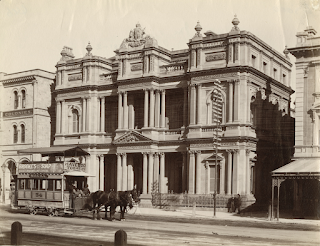
Edmund Wright House - SLSA B 43000
Built between 1875 and 1878, the building now known as The Edmund Wright Building was designed by architects Edmund Wright and Lloyd Taylor for the Bank of South Australia, which was an independent branch of the South Australia Company, formed in 1835, in London.
The building opened on the 2nd of June 1878 and cost 63,000 pounds to construct.
For most of its life, the building has been used as a bank, changing hands from the Bank of South Australia, to the Union Bank in 1893. Later becoming the ANZ Bank from 1951 until 1971 after which it was sold to Mainline Investments.
Mainline Investments proposed a 19-story office block to be built on the site in 1971. A public campaign saved the ornate building from demolition. The Minister for Public Works purchased the property for $750,000 and renamed it Edmund Wright House. It has since been used by The Registrar of Births, Deaths and Marriages, and as a migrant resource centre. Its lower bank vaults are used on occasion for music recitals and meetings.
The design of the building is in the style “Corinthian” and features carved friezes, carved spandrels, carved keystones, and a carved tympanum featuring the banks shield.
The former vaults of the bank in the basement, and the upper levels of this building, are thought to be haunted by a man named “Tom” who is said to have been stabbed to death in the building, although no record of such an incident can be verified.
Debbie, who visited the Adelaide City Library during my residency for the Haunted Buildings in Adelaide project, once worked inside the building and described how the lift would often operate by itself, she would look up expecting someone to leave the lift, but it would be empty…
Lights also had a habit of being turned on or off within the building when no-one was visibly near the light switches, but perhaps the eeriest of experiences for Debbie was the calling of her name (and of other staff members) by a disembodied voice in the building, one that none of the staff recognised, or could locate the source from which it emanated!
© Allen Tiller 2019
December 23, 2019
Phineas Philip Davies (31 March 1865 – 28 Dec 1885)
Phineas Philip Davies (31 March 1865 – 28 Dec 1885)
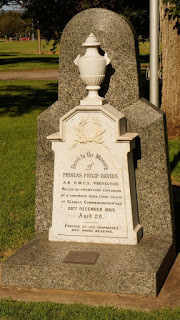 Commemoration Day, December 28th, 1885. The South Australian Colony’s only warship, the HMS Protector was sitting off the coast at Glenelg, awaiting to fire its guns in salute to the forty-ninth year of the settlement of the colony.
Commemoration Day, December 28th, 1885. The South Australian Colony’s only warship, the HMS Protector was sitting off the coast at Glenelg, awaiting to fire its guns in salute to the forty-ninth year of the settlement of the colony.It was the first time the HMS Protector had been allowed to fire its guns in salute.
The canons fired five times, then suddenly, the ship's flags were lowered and it steamed of towards Port Adelaide. Onboard, the crews were in full medical mode. The canons had fired, but something had gone wrong, and two crew members were seriously injured.
Daniel Cann, in charge of canon number 5 was severely maimed by an explosion of the canon and was sent to Semaphore Hospital. He survived the explosion but lost an eye and was disfigured.
Phineas Philip Davies, on the other hand, had received the full force of the blast from the cannon breech and died on board the ship.An inquest was held on Tuesday the 29th of December 1884 at the Largs Pier Hotel by the city coroner Mr T. Ward. The Coroner and Jury were taken to the warship to inspect the gun. Sitting alongside the gun was the coffin and body of Davies.
Master Gunner Haisom explained to the audience how the gun works, and then what they believed went wrong.
 Haisom explained that Davies was positioned at gun 5, position two. Haisom had himself gone around to every gun and supplied each with a bucket of water to sponge out the excess gunpowder after each firing. He then informed the gunners they had 50 seconds to reload after each firing.
Haisom explained that Davies was positioned at gun 5, position two. Haisom had himself gone around to every gun and supplied each with a bucket of water to sponge out the excess gunpowder after each firing. He then informed the gunners they had 50 seconds to reload after each firing.At 12 o’clock they began to fire the guns.
The number 5 gun fired two rounds, with its crew, including Davies, preparing for shot three. Davies entered the charge, which exploded on contact. Davies had neglected to sponge the gun after the last firing, leaving lit residue in the canon, which exploded the new 10 Lb powder charge.
Davies gun commander, Daniel Canns, was subsequently accused of not delivering the order to sponge the canon between shots, something that was standard procedure.
The jury deliberated on the evidence for quite some time, but in the end, delivered a verdict of accidental death.
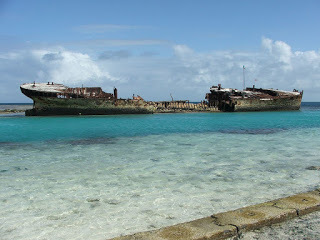 The remains of Protector at Heron Island in 2008 at low tide
The remains of Protector at Heron Island in 2008 at low tideA memorial was erected to Davies at Cheltenham Cemetery and was claimed by the Royal Australian Navy in December 1986. The Memorial to Davies was installed as the headpiece of the South Australian Naval Memorial Garden at H.M.A.S. Encounter until the memorial was relocated to its current position in April 1995.
Front InscriptionSacred to the MemoryofPHINEAS PHILIP DAVIES,A.B. H.M.C.S. PROTECTOR. Killed By Premature ExplosionOf A Cartridge When Firing SaluteAt Glenelg Commemoration Day 28th DECEMBER 1885. Aged 20.
Erected By His ShipmatesAnd Naval Reserve
Plaque: This tombstone marked the site of thegrave of Phineas Davies in CheltenhamCemetery for 100 years and was claimedby the Royal Australian Navy in December1986. It was installed as the headpiece ofthe South Australian Naval MemorialGarden at HMAS ENCOUNTER until theGarden was relocated to its present sitein April 1995.
(Note: Phineas Philip Davies was born on the 31st of March 1865 in Dunedin, Otago, New Zealand)
Researched and written by Allen Tiller © 2018
Bibliography
1885 'CORONERS' INQUESTS', South Australian Register (Adelaide, SA: 1839 - 1900), 30 December, p. 7. , viewed 02 Aug 2018, http://nla.gov.au/nla.news-article44536720
1885 'The Fatal Accident on the Protector.', The Express and Telegraph (Adelaide, SA: 1867 - 1922), 30 December, p. 5. (Afternoon Edition.), viewed 02 Aug 2018, http://nla.gov.au/nla.news-article208372973
1885 'THE-FATAL ACCIDENT ON THE PROTECTOR.', The South Australian Advertiser (Adelaide, SA: 1858 - 1889), 30 December, p. 6. , viewed 02 Aug 2018, http://nla.gov.au/nla.news-article36320103
Adelaide (S.A.). Corporation 2003, Historical walking trails, Adelaide, South Australia, City of Adelaide, Adelaide
Ancestry.com. Australia, Death Index, 1787-1985 [database on-line]. Provo, UT, USA: Ancestry.com Operations, Inc., 2010.
Madeleine Ryan, History SA, ‘Naval Memorial’, SA History Hub, History Trust of South Australia, http://sahistoryhub.com.au/things/nav..., accessed 2 March 2018.
Scott, Jenny, 2012, Davies, Phineas Phillip, The State Library of South Australia, 2 March 2018, https://collections.slsa.sa.gov.au/resource/B+72767



